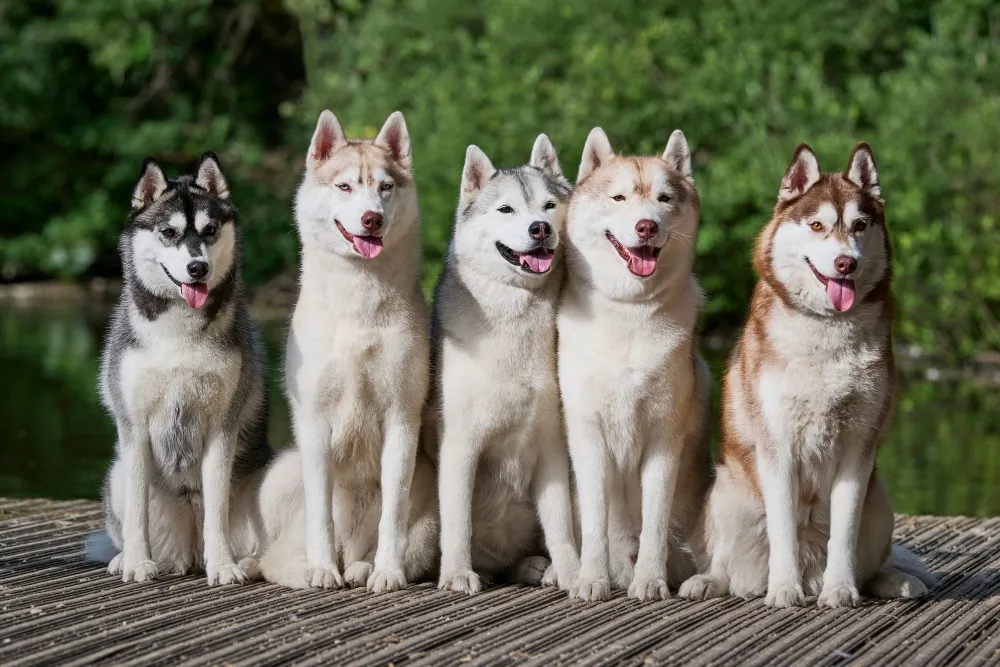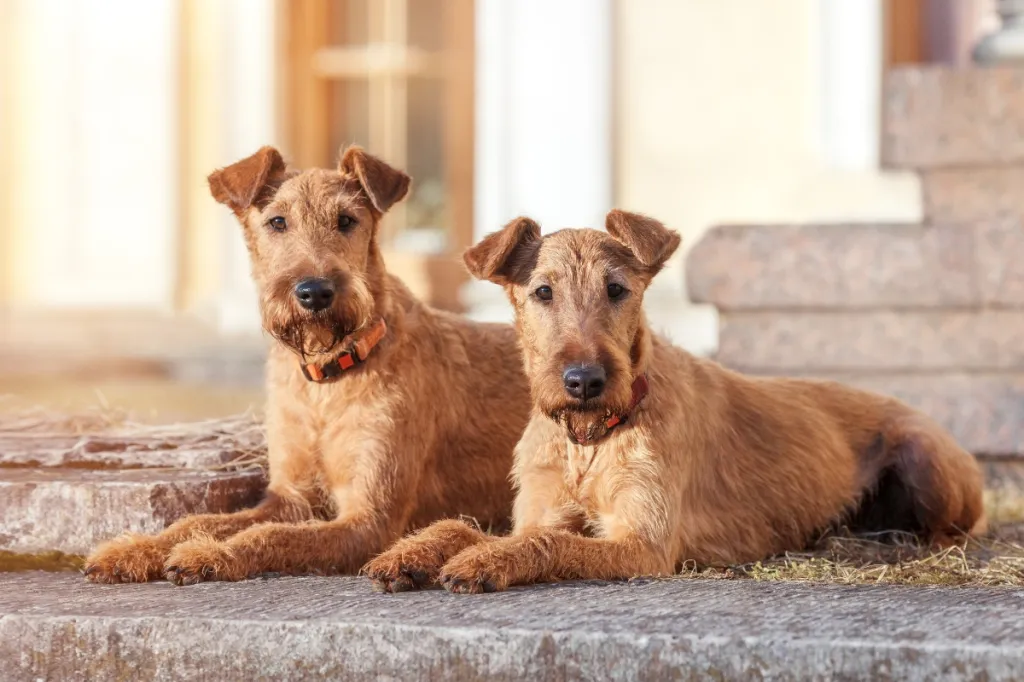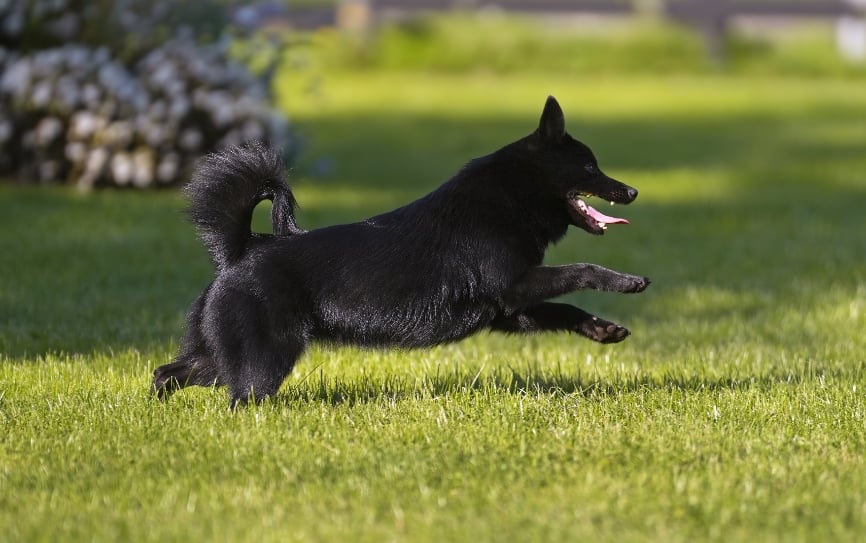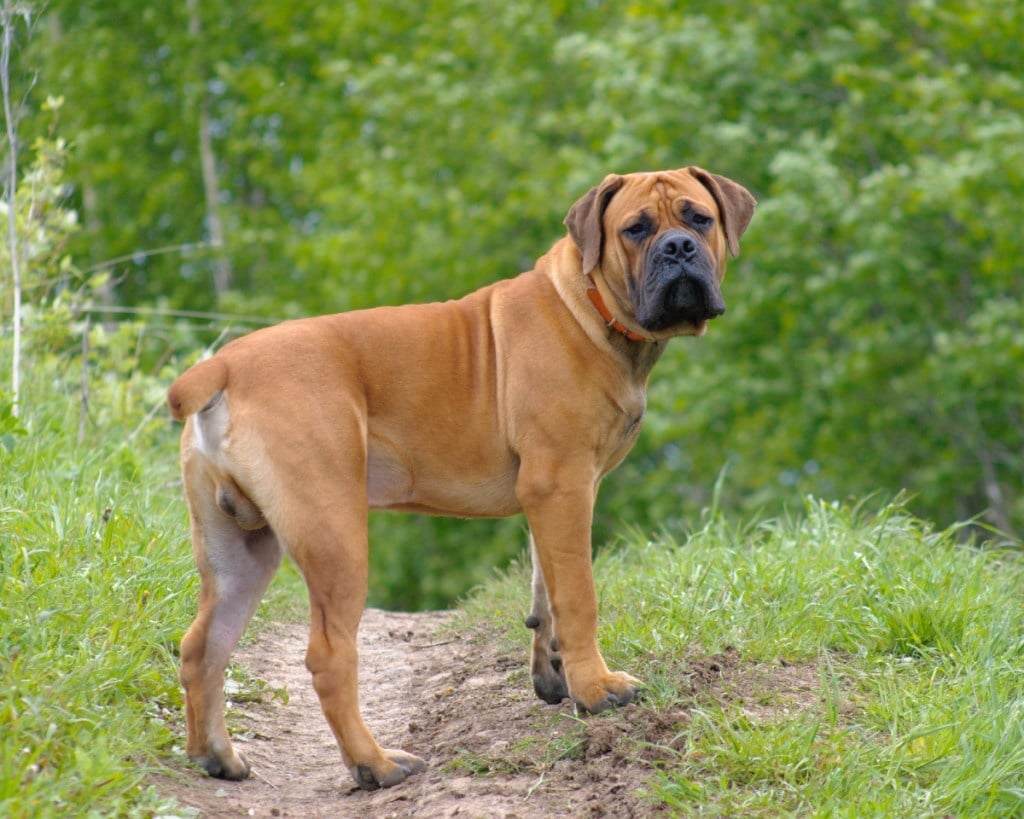Introduction to Huskies
Perhaps best known for pulling sleds in cold and snowy weather, the husky is a stunning dog that is athletic, intelligent, and beautiful. These dogs are moderate in size and tend to be outgoing, loyal, mischievous, hardworking… and vocal. Huskies are fast, powerful, friendly, energetic, and have great endurance. They can do well as both working dogs outside and family dogs in a home, and they are beloved members of families all around the world.
Although the Siberian husky is the most well-known husky dog, there are other types of husky dogs too, which we will describe below in more detail. Yet all of these dogs share many of the same characteristics and are prone to similar health conditions, which you can be proactive about by getting pet health insurance for your dog.
Types of Huskies
Most people refer to the Siberian husky when they talk about husky dogs. Yet other breeds of dogs are commonly called huskies too because of their husky-like qualities and appearance. Siberian huskies have been bred to be sled dogs and as search-and-rescue dogs. Alaskan malamutes are cousins of the Siberian husky and considerably larger while also excelling as sled dogs. A small version of a husky is the Alaskan Klee Kai. The Chinook doesn’t look much like a husky but is also a sled dog and has a large size and friendly personality.
Size of Huskies
Male Siberian huskies typically reach heights between 21 and 23.5 inches when fully grown, while females typically stand at 20 to 22 inches tall. The weight of an adult male Siberian husky is between 45 and 60 pounds, and females weigh 35 to 50 pounds.
Huskies reach their full height at about 12 months old but still gain a bit of weight after that to reach their full adult size. A husky is done growing by about 15 months but still develops muscle until about three years of age.
Here’s how big you can expect your husky to get when fully grown. Keep in mind that every dog is an individual so some variation from what is typical can be expected. Talk to your veterinarian if you are concerned about your husky’s growth.
| Weight Chart | 3 months | 6 months | 15 months |
| Male Huskies | 13 – 22 pounds | 28 – 43 pounds | 45 – 60 pounds |
| Female Huskies | 11 – 20 pounds | 26 – 36 pounds | 35 – 50 pounds |
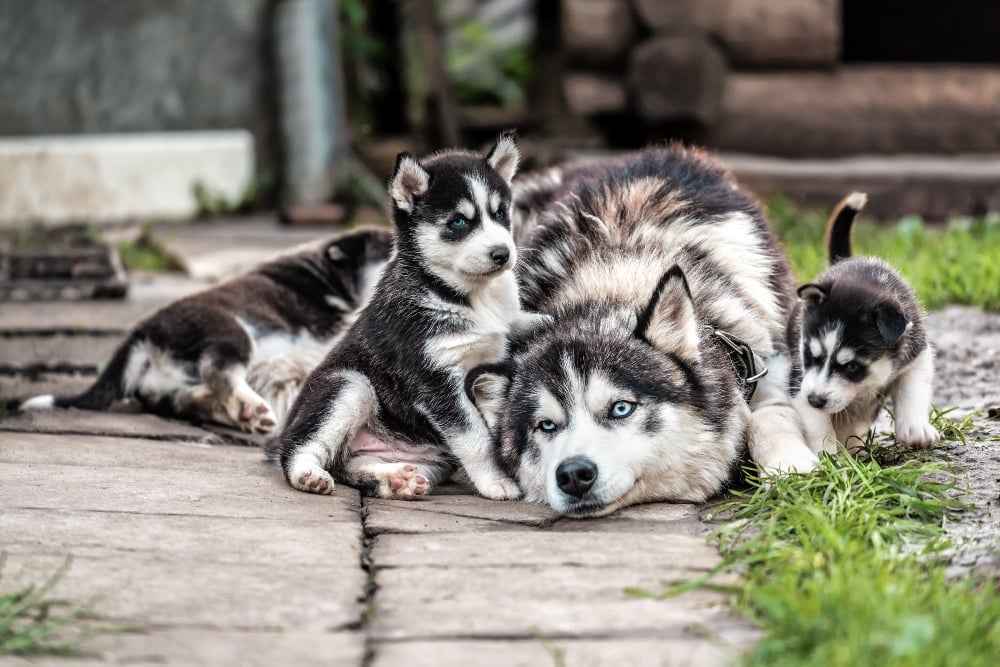
Characteristics of Huskies
Huskies are independent dogs that don’t always need other dogs or children around to be happy. They shed quite a bit but are not likely to drool or need excessive grooming. Most are friendly dogs that find everyone they meet to be a new best friend. They love playing non-stop but don’t make the best watchdogs because they are friendly even to strangers. Huskies do commonly bark and howl though. Other things to know are that huskies are very adaptable, energetic, and require plenty of stimulation to keep busy. A bored husky is likely to get into a lot of trouble!
As you get to know a husky’s personality, here’s what you can expect based on his or her breed characteristics.
| Breed Characteristic | Level (High, Medium, Low) |
| Affectionate with People | High |
| Good with Kids | Medium |
| Good with Pets | Medium |
| Need for Exercise | High |
| Energy Level | High |
| Intelligence Level | High |
| Able to Be Trained | Medium |
| Amount of Vocalizing | High |
| Amount of Shedding | High |
History of Huskies
Huskies are a working group breed of dogs that was first recognized by the American Kennel Club in 1930. However, the ancestors of the Siberian husky breed date back over 3,000 years to Northeast Asia, where the Chukchi tribe developed the dogs to pull sleds and aid their nomadic lifestyle. The Chukchi people needed sled dogs to expand their hunting grounds due to climate changes and dogs that were able to handle sub-zero temperatures.
These dogs were the predecessors of today’s Siberian husky breed, which gained worldwide popularity in the early 1900s when Leonhard Seppala led a team of Siberian huskies 658 miles in 5.5 days to bring medication to Nome, Alaska during a diphtheria epidemic. News of this impressive accomplishment was published all around the world and brought fame to the husky dog breed.
Today, people still use huskies for sled races in pursuit of the sport. Dog sled racing is still popular very in Alaska, for example. However, many other people simply love husky dogs and keep them as household companions that are social and fun.
Huskies Standard Information
The American Kennel Club has developed an official standard for the Siberian husky that describes the ideal characteristics of this purebred dog. This is the standard by which Siberian huskies are judged at dog shows and that are accepted by national and international dog groups.
The general appearance of a Siberian husky is moderately compact, well-furred, and able to carry a light load at a moderate speed over long distances. Here is an overview of the breed standard information for huskies:
Head:
- Keen and friendly expression
- Blue or brown eyes
- Medium-size, triangular ears
- Medium length and width muzzle
- Teeth in scissors bite
Neck, Topline, Body:
- Medium length neck
- Deep and strong chest that is not too broad
- Straight and strong back
Forequarters:
- Shoulder blades well laid back
- Legs moderately spaced, parallel, and straight
- Bone substantial but not heavy
- Pads tough and thickly cushioned
Hindquarters:
- Upper thighs well-muscled and powerful
- Hock joint well-defined and low to ground
- Dewclaws to be removed
Coat:
- Double coat, medium in length
- Soft and dense undercoat to support outer coat
- Absence of undercoat is normal during shedding season
- Trimming of whiskers and fur between toes allowed
Color:
- May be black, gray, agouti, sable, red, or white
- May be solid colored, have white markings, and have multiple shades
- Brindle pattern does not meet standard
Gait:
- Smooth and seemingly effortless gait
- Quick and light on the feet
- Legs gradually angle inward as speed increases
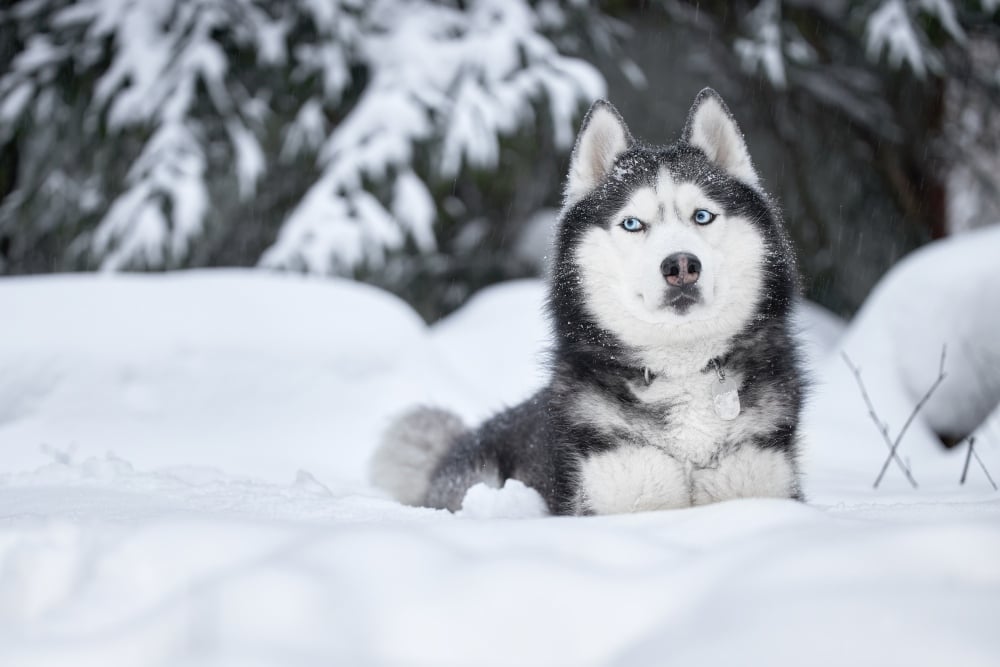
Caring for Huskies
Siberian huskies and other classic northern dogs are intelligent, independent, and stubborn. They love to run and are friendly with people too. These dogs do well with other dogs, especially if they were raised together. They thrive in cool climates rather than warm ones, are known for howling, and have a high prey drive, which means they may chase cats and other animals.
Here are some general tips for taking the best care of a husky.
Best Living Environments:
- Cool climates
- Plenty of space to run
- Exercise for 30-60 minutes daily
- Farms or houses with yards
- Not recommended for apartments unless well-exercised outside the space
Type of Exercise:
- Running and chasing
- Hiking with people
- Snow sports, including dog sledding and cross-country skiing
- Needs plenty of exercise to prevent behavioral problems
Mental Enrichment:
- Don’t leave alone too long to prevent digging, chewing, and other behaviors related to boredom
- Give the dog a designated space to dig in the yard
- Plenty of toys around the house including food puzzles when left alone
Training Strategies:
- Start training early to help dogs focus on people and be more social
- Challenging to train so not best for first-time dog owners
- Train not to escape or wander from home
- Practice crate training and leash training
Grooming Tips:
- Fur less prone to matting that similar dog breeds
- Brush a couple times per week
- More grooming is needed during shedding season
- Heavy shedders for about three weeks, twice per year
- Brush teeth daily
- Trim nails as needed
Common Health Problems of Huskies
The average Siberian husky lives between 12 and 14 years, although different kinds of huskies have different life expectancies. Huskies are prone to juvenile cataracts and benefit from yearly eye exams to detect potential issues early. The National Breed Club recommends that huskies that are part of a breeding program get tested with a hip evaluation and an ophthalmologist evaluation.
These are some of the most common health issues that arise with huskies:
- Hip dysplasia
- Cataracts
- Progressive retinal atrophy
- Corneal dystrophy
Diet and Nutrition for Huskies
Siberian huskies were bred not to need an excess of food per day, and too much food can make this type of dog obese. It surprises many new husky parents to learn that their energetic and hardworking dogs don’t need as many calories as they expected.
People feed huskies commercial dry and wet dog food, raw food, or a combination of the two. Don’t feed a husky for two hours before exercising or 30 minutes after exercising to help prevent gastric torsion and bloat. It’s best to feed huskies two to three meals per day to spread the calories out throughout the day. Nutro Max Chicken Meal and Rice, Orijen, and Innova are recommended brands of dog food for huskies.
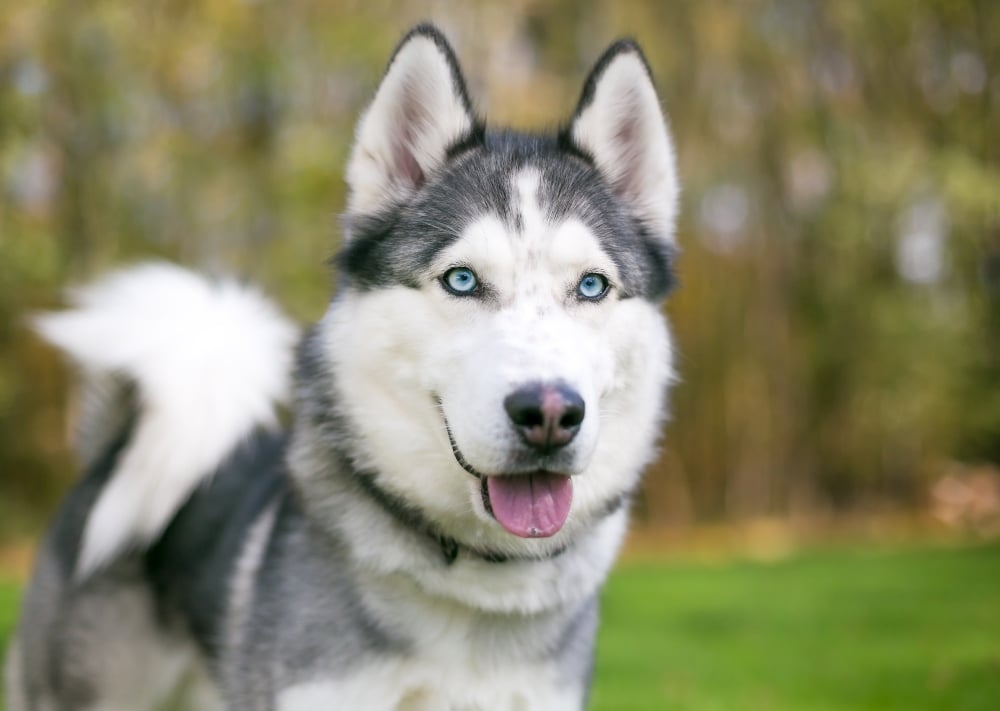
Where to Adopt or Purchase Huskies
Although they are very lovable, huskies have some challenging traits, which sometimes makes them end up in shelters and available for adoption. The Siberian Husky Club of America Trust supports rescue operations for huskies and compiles local contact information for husky rescue groups.
If you choose to purchase a husky, make sure you find a reputable breeder who checks parent dogs for genetic diseases and ensures that the parents have good temperaments. You can find Siberian husky puppies on the AKC marketplace. The Siberian Husky Club of America is a resource for husky education, local clubs, competitions, and rescue groups.
Related Breeds
If you love Siberian huskies, you might also be interested to learn more about related breeds of dogs that share many of the same characteristics. Here are some additional dog breeds to consider for your next pet:
- Alaskan malamute
- Chinook
- Akita
- American Eskimo dog
- Samoyed
- Icelandic sheepdog
- Alaskan Klee Kai
Pet Insurance for Huskies
Affordable and easy-to-understand pet insurance is available for huskies through Healthy Paws. We understand what these dogs need to be safe and healthy, and we are committed to helping you take the very best care of your husky dog.
Check rates on our website to choose the husky pet insurance plan that’s right for you and your beloved companion. From accidents to genetic conditions and routine care, our insurance plans have helped many huskies live longer and happier lives with the people they love.
